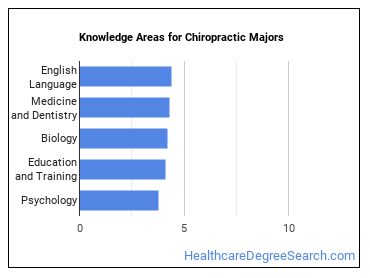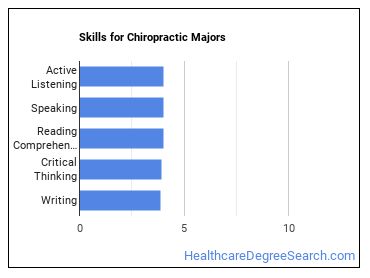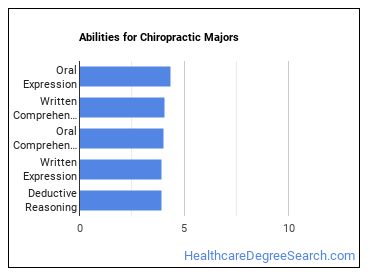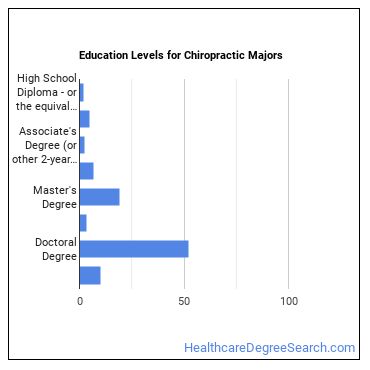Chiropractic
Types of Degrees Chiropractic Majors Are Getting
The following table lists how many chiropractic graduations there were for each degree level during the last year for which data was available.
| Education Level | Number of Grads |
|---|---|
| Doctor’s Degree | 2,698 |
What Chiropractic Majors Need to Know
In an O*NET survey, chiropractic majors were asked to rate what knowledge areas, skills, and abilities were important in their occupations. These answers were weighted on a scale of 1 to 5 with 5 being the most important.
Knowledge Areas for Chiropractic Majors
Chiropractic majors often go into careers in which the following knowledge areas are important:

- English Language - Knowledge of the structure and content of the English language including the meaning and spelling of words, rules of composition, and grammar.
- Medicine and Dentistry - Knowledge of the information and techniques needed to diagnose and treat human injuries, diseases, and deformities. This includes symptoms, treatment alternatives, drug properties and interactions, and preventive health-care measures.
- Biology - Knowledge of plant and animal organisms, their tissues, cells, functions, interdependencies, and interactions with each other and the environment.
- Education and Training - Knowledge of principles and methods for curriculum and training design, teaching and instruction for individuals and groups, and the measurement of training effects.
- Psychology - Knowledge of human behavior and performance; individual differences in ability, personality, and interests; learning and motivation; psychological research methods; and the assessment and treatment of behavioral and affective disorders.
Skills for Chiropractic Majors
The following list of skills has been highlighted as some of the most essential for careers related to chiropractic:

- Reading Comprehension - Understanding written sentences and paragraphs in work related documents.
- Active Listening - Giving full attention to what other people are saying, taking time to understand the points being made, asking questions as appropriate, and not interrupting at inappropriate times.
- Speaking - Talking to others to convey information effectively.
- Critical Thinking - Using logic and reasoning to identify the strengths and weaknesses of alternative solutions, conclusions or approaches to problems.
- Writing - Communicating effectively in writing as appropriate for the needs of the audience.
Abilities for Chiropractic Majors
Chiropractic majors often go into careers where the following abilities are vital:

- Oral Expression - The ability to communicate information and ideas in speaking so others will understand.
- Written Comprehension - The ability to read and understand information and ideas presented in writing.
- Oral Comprehension - The ability to listen to and understand information and ideas presented through spoken words and sentences.
- Written Expression - The ability to communicate information and ideas in writing so others will understand.
- Deductive Reasoning - The ability to apply general rules to specific problems to produce answers that make sense.
What Can You Do With a Chiropractic Major?
People with a chiropractic degree often go into the following careers:
| Job Title | Job Growth Rate | Median Salary |
|---|---|---|
| Chiropractors | 12.4% | $71,410 |
| Health Specialties Professors | 25.9% | $97,370 |
Amount of Education Required for Careers Related to Chiropractic
Some careers associated with chiropractic require an advanced degree while some may not even require a bachelor’s. Whatever the case may be, pursuing more education usually means that more career options will be available to you.
How much schooling do you really need to compete in today’s job market? People currently working in careers related to chiropractic have obtained the following education levels.

| Education Level | Percentage of Workers |
|---|---|
| High School Diploma - or the equivalent (for example, GED) | 1.7% |
| Post-Secondary Certificate - awarded for training completed after high school (for example, in agriculture or natural resources, computer services, personal or culinary services, engineering technologies, healthcare, construction trades, mechanic and repair technologies, or precision production) | 4.7% |
| Associate’s Degree (or other 2-year degree) | 2.4% |
| Bachelor’s Degree | 6.6% |
| Master’s Degree | 18.9% |
| First Professional Degree - awarded for completion of a program that: requires at least 2 years of college work before entrance into the program, includes a total of at least 6 academic years of work to complete, and provides all remaining academic requirements to begin practice in a profession. | 3.6% |
| Doctoral Degree | 52.0% |
| Post-Doctoral Training | 10.1% |
Online Chiropractic Programs
The following table lists the number of programs by degree level, along with how many schools offered online courses in the field.
| Degree Level | Colleges Offering Programs | Colleges Offering Online Classes |
|---|---|---|
| Certificate (Less Than 1 Year) | 0 | 0 |
| Certificate (1-2 years) | 0 | 0 |
| Certificate (2-4 Years) | 0 | 0 |
| Associate’s Degree | 0 | 0 |
| Bachelor’s Degree | 0 | 0 |
| Post-Baccalaureate | 0 | 0 |
| Master’s Degree | 0 | 0 |
| Post-Master’s | 0 | 0 |
| Doctor’s Degree (Research) | 1 | 0 |
| Doctor’s Degree (Professional Practice) | 17 | 0 |
| Doctor’s Degree (Other) | 0 | 0 |
Explore Major by State
Alabama
California
District of Columbia
Idaho
Kansas
Maryland
Mississippi
Nevada
New York
Oklahoma
South Carolina
Utah
West Virginia
Alaska
Colorado
Florida
Illinois
Kentucky
Massachusetts
Missouri
New Hampshire
North Carolina
Oregon
South Dakota
Vermont
Wisconsin
References
*The racial-ethnic minorities count is calculated by taking the total number of students and subtracting white students, international students, and students whose race/ethnicity was unknown. This number is then divided by the total number of students at the school to obtain the racial-ethnic minorities percentage.
- College Factual
- College Scorecard
- National Center for Education Statistics
- O*NET Online
- U.S. Bureau of Labor Statistics
- Usual Weekly Earnings of Wage and Salary Workers First Quarter 2020
- Image Credit: By Michael Dorausch under License
More about our data sources and methodologies.
